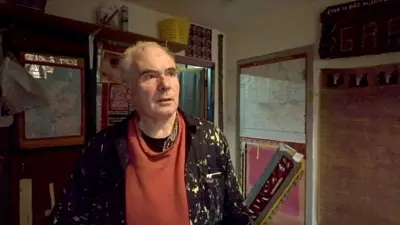We've updated our Privacy and Cookies Policy
We've made some important changes to our Privacy and Cookies Policy and we want you to know what this means for you and your data.
New hope for one of world's most endangered reptiles
Image source, Ashish Bashyal_ZSL
- Author, Helen Briggs
- Role, 91ČČąŹ News
Baby crocodiles found living in a remote region of Nepal give hope for the future of one of the rarest and strangest reptiles on earth.
With its distinctive long thin snout, the gharial is unique but critically endangered, with fewer than a thousand adults remaining in the wild.
The discovery of 100 hatchlings is a boost for the potential recovery of the species, according to scientists.
The crocodile is clinging to survival in India, Nepal and Bangladesh.
Revealing details of the find, researcher Rikki Gumbs of ZSL (Zoological Society of London) said it was amazing to find the baby crocodiles basking on a sand bank in Bardia National Park.
"Given the species is limited to around five populations across its entire range, this is such a positive discovery, and a critical step for the long-term recovery of the species in Nepal," he said.
Image source, Rikki Gumbs_ZSL
"After trekking through the jungle for hours to sit on a ridge and finally catch a glimpse of the hatchlings below us - it was an incredible moment to capture," said Ashish Bashyal, who leads the conservation project in Nepal.
"At around 30cm in size, they look exactly like miniature versions of adult gharials - so incredibly cute," he said.
The 100 baby crocs, together with three adult females and one adult male, were discovered in June, but details are only now being revealed to aid conservation efforts. The crocodile has not been sighted in the area in 30 years.
There is encouraging news in that the hatchlings have recently been spotted again after the monsoon rain.
"They've made it through the first big hurdle," Rikki Gumbs told 91ČČąŹ News. "Especially with the threats that are impacting the species, it's very important that these hatchlings can make it to adulthood."
Once present across much of the Indian subcontinent, the gharial (Gavialis gangeticus) is virtually extinct across much of its former range, with fewer than 100 adult crocodiles remaining in Nepal and several fragmented populations in India. Only one other breeding population is known in Nepal, at Chitwan National Park.
Image source, Ashish Bashyal _ZSL
The crocodile poses little danger to humans. Hunting and egg collection are now prohibited, but severe pressures remain, including loss of habitat due to the construction of dams, as well as pollution, fishing, agriculture and predation from another species of crocodile found in Nepal.
Adult gharials are large, with males reaching over 5 metres in length and 250kg in weight. Males develop a lump on the end of their snouts, known as a gharas, which gives the species its name.
The gharial is ranked at number 17 on ZSL's EDGE (Evolutionary Distinct and Globally Endangered) of Existence programme Reptiles list.
Follow Helen
Top Stories
More to explore
Most read
Content is not available








